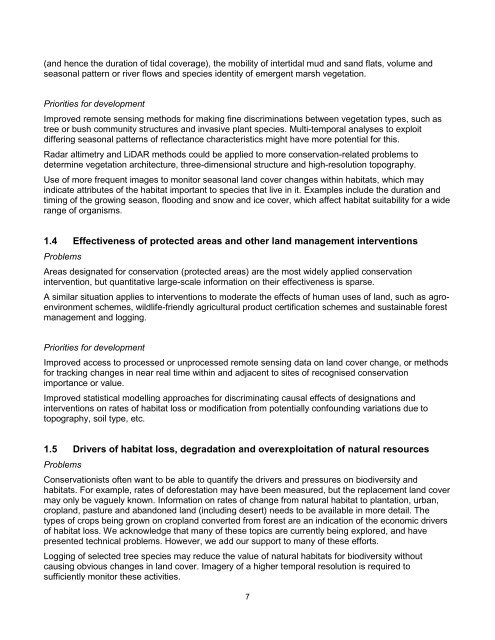What do conservation practitioners want from remote sensing?
Report: What do conservation practitioners want from remote sensing?
Report: What do conservation practitioners want from remote sensing?
- No tags were found...
Create successful ePaper yourself
Turn your PDF publications into a flip-book with our unique Google optimized e-Paper software.
(and hence the duration of tidal coverage), the mobility of intertidal mud and sand flats, volume and<br />
seasonal pattern or river flows and species identity of emergent marsh vegetation.<br />
Priorities for development<br />
Improved <strong>remote</strong> <strong>sensing</strong> methods for making fine discriminations between vegetation types, such as<br />
tree or bush community structures and invasive plant species. Multi-temporal analyses to exploit<br />
differing seasonal patterns of reflectance characteristics might have more potential for this.<br />
Radar altimetry and LiDAR methods could be applied to more <strong>conservation</strong>-related problems to<br />
determine vegetation architecture, three-dimensional structure and high-resolution topography.<br />
Use of more frequent images to monitor seasonal land cover changes within habitats, which may<br />
indicate attributes of the habitat important to species that live in it. Examples include the duration and<br />
timing of the growing season, flooding and snow and ice cover, which affect habitat suitability for a wide<br />
range of organisms.<br />
1.4 Effectiveness of protected areas and other land management interventions<br />
Problems<br />
Areas designated for <strong>conservation</strong> (protected areas) are the most widely applied <strong>conservation</strong><br />
intervention, but quantitative large-scale information on their effectiveness is sparse.<br />
A similar situation applies to interventions to moderate the effects of human uses of land, such as agroenvironment<br />
schemes, wildlife-friendly agricultural product certification schemes and sustainable forest<br />
management and logging.<br />
Priorities for development<br />
Improved access to processed or unprocessed <strong>remote</strong> <strong>sensing</strong> data on land cover change, or methods<br />
for tracking changes in near real time within and adjacent to sites of recognised <strong>conservation</strong><br />
importance or value.<br />
Improved statistical modelling approaches for discriminating causal effects of designations and<br />
interventions on rates of habitat loss or modification <strong>from</strong> potentially confounding variations due to<br />
topography, soil type, etc.<br />
1.5 Drivers of habitat loss, degradation and overexploitation of natural resources<br />
Problems<br />
Conservationists often <strong>want</strong> to be able to quantify the drivers and pressures on biodiversity and<br />
habitats. For example, rates of deforestation may have been measured, but the replacement land cover<br />
may only be vaguely known. Information on rates of change <strong>from</strong> natural habitat to plantation, urban,<br />
cropland, pasture and aban<strong>do</strong>ned land (including desert) needs to be available in more detail. The<br />
types of crops being grown on cropland converted <strong>from</strong> forest are an indication of the economic drivers<br />
of habitat loss. We acknowledge that many of these topics are currently being explored, and have<br />
presented technical problems. However, we add our support to many of these efforts.<br />
Logging of selected tree species may reduce the value of natural habitats for biodiversity without<br />
causing obvious changes in land cover. Imagery of a higher temporal resolution is required to<br />
sufficiently monitor these activities.<br />
7




